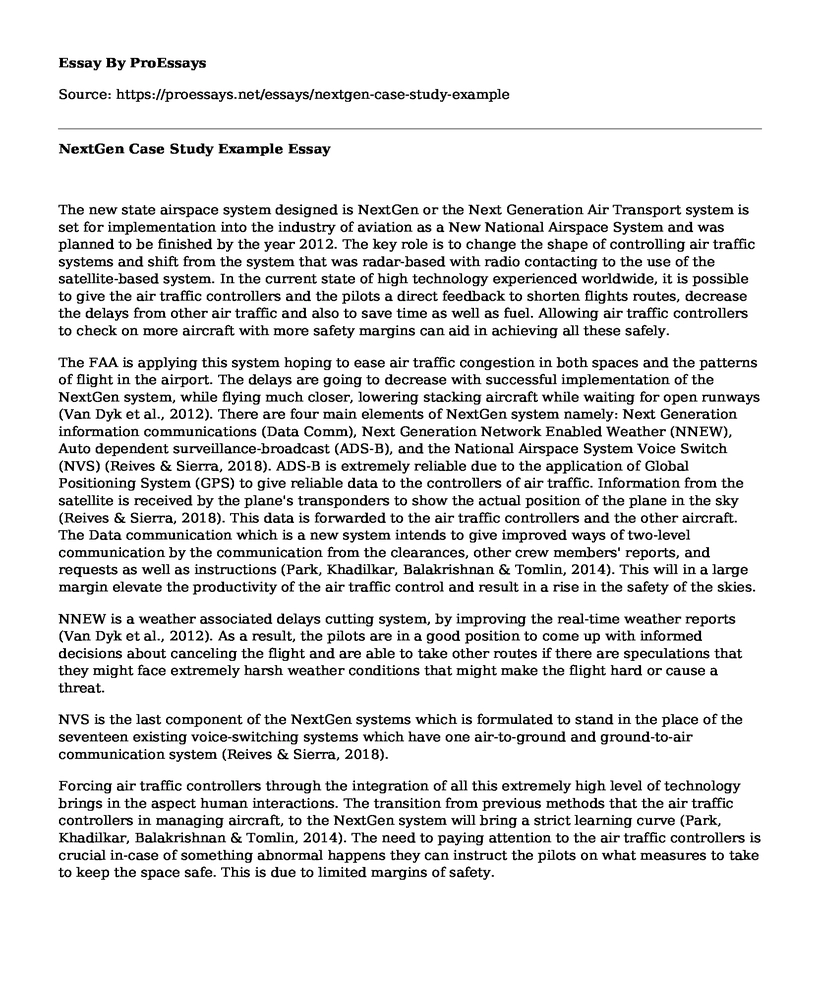The new state airspace system designed is NextGen or the Next Generation Air Transport system is set for implementation into the industry of aviation as a New National Airspace System and was planned to be finished by the year 2012. The key role is to change the shape of controlling air traffic systems and shift from the system that was radar-based with radio contacting to the use of the satellite-based system. In the current state of high technology experienced worldwide, it is possible to give the air traffic controllers and the pilots a direct feedback to shorten flights routes, decrease the delays from other air traffic and also to save time as well as fuel. Allowing air traffic controllers to check on more aircraft with more safety margins can aid in achieving all these safely.
The FAA is applying this system hoping to ease air traffic congestion in both spaces and the patterns of flight in the airport. The delays are going to decrease with successful implementation of the NextGen system, while flying much closer, lowering stacking aircraft while waiting for open runways (Van Dyk et al., 2012). There are four main elements of NextGen system namely: Next Generation information communications (Data Comm), Next Generation Network Enabled Weather (NNEW), Auto dependent surveillance-broadcast (ADS-B), and the National Airspace System Voice Switch (NVS) (Reives & Sierra, 2018). ADS-B is extremely reliable due to the application of Global Positioning System (GPS) to give reliable data to the controllers of air traffic. Information from the satellite is received by the plane's transponders to show the actual position of the plane in the sky (Reives & Sierra, 2018). This data is forwarded to the air traffic controllers and the other aircraft. The Data communication which is a new system intends to give improved ways of two-level communication by the communication from the clearances, other crew members' reports, and requests as well as instructions (Park, Khadilkar, Balakrishnan & Tomlin, 2014). This will in a large margin elevate the productivity of the air traffic control and result in a rise in the safety of the skies.
NNEW is a weather associated delays cutting system, by improving the real-time weather reports (Van Dyk et al., 2012). As a result, the pilots are in a good position to come up with informed decisions about canceling the flight and are able to take other routes if there are speculations that they might face extremely harsh weather conditions that might make the flight hard or cause a threat.
NVS is the last component of the NextGen systems which is formulated to stand in the place of the seventeen existing voice-switching systems which have one air-to-ground and ground-to-air communication system (Reives & Sierra, 2018).
Forcing air traffic controllers through the integration of all this extremely high level of technology brings in the aspect human interactions. The transition from previous methods that the air traffic controllers in managing aircraft, to the NextGen system will bring a strict learning curve (Park, Khadilkar, Balakrishnan & Tomlin, 2014). The need to paying attention to the air traffic controllers is crucial in-case of something abnormal happens they can instruct the pilots on what measures to take to keep the space safe. This is due to limited margins of safety.
Conclusion
However, human factor hazards are there when making and programming the new systems ahead of their implementation. If a mistake is made for example by a computer programmer or an engineer while trying to design the new systems, might end up becoming a disastrous occurrence if they are put in place for the use by air traffic controllers. The NextGen system has been rolled out and is already working. This will amount to the urge of learning and work out for everybody. Continuous monitoring of the systems, adequate training of all staffs that will be operating them is supposed to bring about a good and easy shift and lead to a much effective system of air transport.
References
Park, P., Khadilkar, H., Balakrishnan, H., & Tomlin, C. J. (2014). High confidence networked control for next-generation air transportation systems. IEEE Transactions on Automatic Control, 59(12), 3357-3372.
Reives, A., & Sierra, E. (2018). Integration of Human Factors in the NextGen Air Transportation System Lifecycle Acquisition Management Process | SEDC Conference 2016. Retrieved from http://www.sedcconference.org/integration-of-human-factors-in-the-nextgen-air-transportation-system-lifecycle-acquisition-management-process/
Van Dyk, R. N., Pariseau, D. H., Dodson, R. E., Martin, B. T., Radcliffe, A. T., Austin, E. A., ... & Werner, J. H. (2012, April). Systems integration of unmanned aircraft into the national airspace: Part of the federal aviation administration next generation air transportation system. In Systems and Information Design Symposium (SIEDS), 2012 IEEE (pp. 156-161). IEEE.
Cite this page
NextGen Case Study Example. (2022, May 17). Retrieved from https://proessays.net/essays/nextgen-case-study-example
If you are the original author of this essay and no longer wish to have it published on the ProEssays website, please click below to request its removal:
- Religion Essay Example - Adolescent Development and Faith Formation
- Essay Sample: Interview on a Personality's Lifespan Development
- Research Paper on Developmental Stage Theory
- Ways in Which Individuals Can Effectively Deal With Developmental Challenges - Essay Sample
- Essay Example on Marxism: Exploring Social Development and Human Nature
- Unlocking the Secrets of Our Neandertal Relatives: 400,000 Years of History - Essay Sample
- Free Essay Sample on Exploring and Terraforming Mars: A Feasible Proposal for Human Colonization







